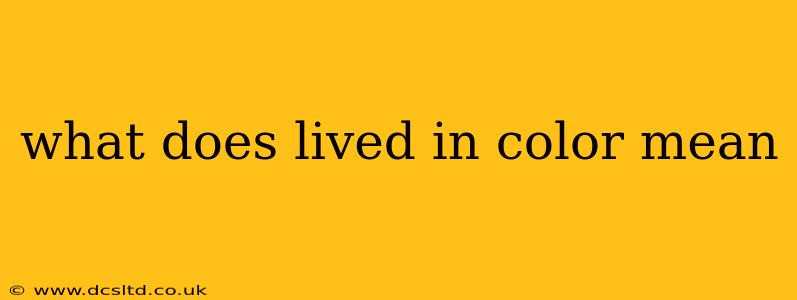The term "lived-in color" is a popular phrase in the hair coloring world, but it also applies to other aspects of design and aesthetics. It describes a color that appears natural, soft, and subtly dimensional, as if it's been naturally faded or highlighted by the sun or elements over time. It avoids the harsh, unnatural look often associated with overly saturated or uniformly applied color. Think less "fresh from the salon" and more "effortlessly chic."
Let's dive deeper into what makes lived-in color so desirable:
What are the Characteristics of Lived-In Color?
Lived-in color is characterized by several key features:
-
Subtle Highlights and Lowlights: Instead of a single, uniform shade, lived-in color incorporates subtle variations in tone. This creates depth and dimension, making the hair look more natural and less processed. These variations are often blended seamlessly, avoiding harsh lines or stark contrasts.
-
Soft, Natural-Looking Fading: The color doesn't look perfectly uniform; instead, it features a gradual transition between shades. This mimics the way hair naturally fades in the sun, with lighter pieces at the ends and slightly deeper tones near the roots.
-
Multi-Dimensional Appearance: This is arguably the most crucial aspect. Lived-in color isn't flat; it possesses depth and complexity, reflecting light in different ways to create a dynamic and visually interesting look.
-
Low-Maintenance Appeal: Because the color is designed to appear natural, it requires less frequent touch-ups than many other coloring techniques. The gradual fading and subtle variations make regrowth less noticeable.
How Does Lived-In Color Differ From Other Coloring Techniques?
Lived-in color stands apart from other techniques in its focus on natural-looking results:
-
Compared to Full Coverage Color: Full coverage color aims for a uniform shade from root to tip, often resulting in a more artificial appearance. Lived-in color embraces subtle variations and avoids complete uniformity.
-
Compared to Balayage: While balayage is a technique often used to achieve lived-in color, the two aren't synonymous. Balayage focuses on painting highlights onto the hair, whereas lived-in color is a broader aesthetic encompassing various techniques to achieve a naturally faded look.
-
Compared to Ombre: Ombre features a more dramatic transition between two distinct colors, often with a clear demarcation line. Lived-in color maintains a softer, more blended transition.
How is Lived-In Color Achieved?
Hair stylists employ several techniques to create a lived-in color effect, including:
- Balayage: A freehand painting technique that creates subtle highlights.
- Foilyage: Similar to balayage, but uses foils for more precise placement of highlights.
- Babylights: Extremely fine highlights that mimic the subtle sun-kissed effect.
- Lowlighting: Adding darker strands to create depth and contrast.
- Color Melting: Blending multiple shades seamlessly to create a natural gradient.
What are the Best Colors for a Lived-In Look?
The best colors for a lived-in look are those that mimic natural hair colors or subtle variations within a single color family. Popular choices include:
- Sun-kissed blondes: Blondes with subtle highlights and lowlights that create a naturally faded appearance.
- Honey browns: Rich brown tones with hints of caramel or golden highlights.
- Auburn reds: Deep red tones with hints of copper or mahogany.
What if My Hair is Already Colored? Can I Achieve a Lived-In Look?
Yes! A skilled stylist can work with your existing color to create a lived-in effect. They may use techniques like toning, glazing, or adding highlights or lowlights to blend your current color into a more natural-looking style.
By understanding the nuances of lived-in color, you can communicate your desired look effectively to your stylist and achieve a beautiful, low-maintenance, and effortlessly chic appearance.
